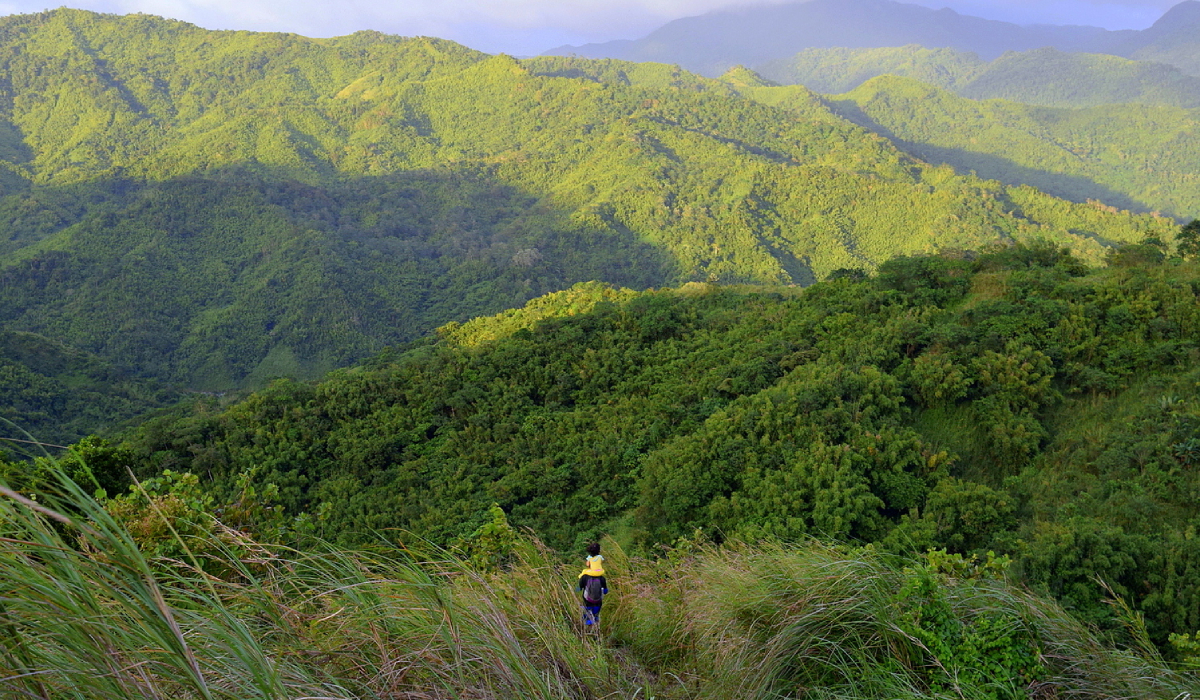We have been hiking for two hours in pitch-black darkness; six hours prior, in unbearable noon heat. I was wet, frustrated, and spent. I glanced at poor Lia, asleep on some guy’s shoulder. It could be our guide or any of the cluster of men who fetched us at the river. I didn’t know anymore. All I know was I never want to hike again.
We arrived in Laiban’s barangay hall at 11:30 am after a series of transfers that seemed longer than Filipino soap operas. We were to hike Laiban Circuit in Tanay, Rizal, a 16-kilometer hiking route consisting of three peaks – Mt. Lubo, Mt. Ngusong Kabayo, and Tangwa Peak – and culminates in multi-tiered Laiban Falls.
We were brimming with hope as Laiban
kagawad Kaka drove us on his
habal-habal and pointed at several peaks, from General Nakar to Rizal. The drive going to the hall wasn’t breezy all the way. Our motorbike halted and treaded carefully and over again as it crossed one stream to another. But the sky was a beautiful December blue, and we couldn’t imagine it raining even if it did the past days.
A woman at the town hall looked at the four of us –
Celine, Dennis, Lia, and me – and chuckled nervously. “Here’s the truth,” she said, heaving a deep sigh, “You will climb three peaks. After that, you will cross several waterfalls. It takes us locals around three hours to complete the route. You have a four year-old with you. The trail is wet. It will take you at least five to six hours. It will be nightfall by the time you finish.”
She was waiting for us to throw in the towel and just call it a day. We spent four hours from Cubao going there. There’s no way we will do that.
 |
| Swinging it at the barangay hall. Pre-hike. |
“Kaya namin ‘yan, ate (We can do it),” we replied in chorus. The high I felt, being among the first ones to have set foot on the circuit since it opened in October, made me oblivious to the difficulties that lied ahead.
The sun bore down as we walked the uphill path to Mt. Lubo, the first and lowest mountain in the circuit. Trees were scarce. The steep incline, coupled with the searing sun, didn’t make things easy. Locals can reach the 488-meter high summit in 30 to 45 minutes. We did it in two hours.
 |
| At the foot of Ngusong Kabayo. Photo by Dennis Murillo. |
From Mt. Lubo, we had an excellent perspective of the second summit:
Ngusong Kabayo. Ngusong Kabayo means “horse’s snout” in the vernacular, and after an hour of passing through exposed grasslands and bamboo forests, you will see why.
Pointy, craggy, and precarious, its rock formations resemble a horse’s snout. Thrill-seekers may opt to scramble to the top (considered the summit at 602 masl), but we were just happy to finally find shade and eat our lunch of homemade spaghetti at the base.
 |
| One of a number of bamboo forests on the circuit |
Tangwa Peak, though the highest peak in the circuit at 625 masl, is the easiest to get to. One simply has to navigate the narrow tunnels of Ngusong Kabayo (which are pretty manageable even for a kid) for around 30 minutes.
 |
| A passage at the base of Ngusong Kabayo that hikers must negotiate to get to Tangwa Peak |
Like many mountains in Rizal, Tangwa offers a panorama of the Sierra Madre Mountain Range. Those who start very early in the morning are in for a treat: Tangwa Peak is famous for magnificent sunrises and a sea of clouds.
We enjoyed the view so much that we stayed here until way past 4 pm, which later proved to be excessive. We were only halfway done, and darkness was looming on the horizon.
 |
| Tangwa Peak |
Over the next hours, grasslands became our constant. We were flanked by 4-foot tall grass on either side. The sight of nearby mountains Binutasan and Sapari afforded us relief from monotony, though only brief. I got cuts from sharp blades of grass and slipped more than I can count that eventually, the joke lost its novelty.
As the sun dimmed and everything turned black, debility overcame me. I couldn’t even carry Lia. We aren’t even at the main falls yet, and there are a few before we can complete the circuit.
Things weren’t going so well for Lia either. She didn’t refuse to be carried by our guide – which is rather unusual. She usually enjoys hikes. She no longer did.
By the time we got to the first leg of the falls at past six, she was exhausted, scared of the dark, and wailing like a beast. What have I gotten ourselves into, I thought.
 |
| First part of Laiban falls |
I remember refilling our depleted water bottles from a nearby stream. No longer caring as Celine and Dennis mused about stars and fireflies overhead. Being fetched by a group of worried barangay officials somewhere along the way. A short but heart-pounding vertical scramble down a gushing waterfall and entrusting my asleep daughter to a stranger.
But everything in between during those final hours was a blur. We were walking nonstop. We couldn’t afford breaks. Food and rest became my obsession.
 |
| Trail from Tangwa Peak going to Laiban Falls |
Our cellphone torches offered little help. We played everything by ear. But in a night hike that only has sound of water, our hearing probably didn’t help much either.
By the end of the nearly nine-hour hike, Kaka noticed my silence. “You aren’t used to these kinds of hike, are you?” he asked.
“Apparently not,” I replied with utter embarrassment. There was no thrill or joy in my voice. Only the certainty that I am fucking tired of mountains.
We came to Laiban without a hint of the terrain we are dealing with. We didn’t even know those mountains’ names. We had a local guide. What could possibly go wrong?
A lot mentally, as it turns out.
I went there thinking, “We’ve hiked the highest peak in Luzon. We’ve hiked a considerable number of mountains. These are average-height mountains. Three are doable.”
 |
| Celine at Tangwa Peak |
I was that annoying hiker who underestimated mountains based on their sheer height and the negligible knowledge I incurred from past hikes. For Christ’s sake, I didn’t even know how to pitch a tent. I wasn’t prepared. Yet, there I was, priding myself in what little I knew.
Mountains are unforgiving. However small, one has the power to destroy your will. Mountains do not adjust to humans. Humans adjust to mountains. Once we step foot on a mountain, we are at the mercy of the elements. We are in nature’s territory. Out there, anything can happen.
The next day found me crushed, both body and spirit. The proud woman who hiked to prove she knows something only to be proven she doesn’t know anything. I wanted nothing to do with mountains, because I wasn’t worthy of them.
It took more than a month before I had the courage to go at it again. The beautiful thing about mountains is that if you keep your eyes open and come to experience them without prior judgement or expectations, there are life-changing lessons to be learned that are worth keeping. Above all, this: Mountains hurt, but they are home.
Much thanks to the sweet tanods who went to check on us, Kaka, and our amazing guide, Kuya Efren, who tirelessly carried then-17 kilogram Lia for nearly seven hours. We are eternally grateful for your thoughtfulness and concern. The people of Laiban are a gem.
P.S.
- Pinoy Mountaineer rates this circuit as 3/9 in difficulty, according it the same level as Mt. Pulag via the Ambangeg trail, Arayat, and Balagbag. I can tell you it’s much harder than those mountains. I’d probably rate it at 4.5 to 5/10, particularly the descent from Tangwa Peak to the falls. It’s very slippery especially during the rainy season. Going down the falls requires a bit of scrambling. Come prepared.
- This is an account of our hike in December 2016. Things might have changed since then. Refer to the contact person below for inquiries.
- For inquiries on hiking the Laiban circuit, contact Kagawad Kaka Munoz at +639984943595 or send him a Facebook message.
- Celineism has a useful Laiban Circuit guide with expenses, itinerary, and directions. Check it our here.
- Contact details and schedule of fees as of 2016:



















